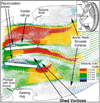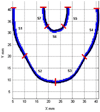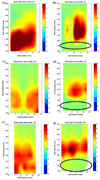Towards non-thrombogenic performance of blood recirculating devices
- PMID: 20131098
- PMCID: PMC2862578
- DOI: 10.1007/s10439-010-9905-9
Towards non-thrombogenic performance of blood recirculating devices
Abstract
Implantable blood recirculating devices have provided life saving solutions to patients with severe cardiovascular diseases. However, common problems of hemolysis and thromboembolism remain an impediment to these devices. In this article, we present a brief review of the work by several groups in the field that has led to the development of new methodologies that may facilitate achieving the daunting goal of optimizing the thrombogenic performance of blood recirculating devices. The aim is to describe work which pertains to the interaction between flow-induced stresses and the blood constituents, and that supports the hypothesis that thromboembolism in prosthetic blood recirculating devices is initiated and maintained primarily by the non-physiological flow patterns and stresses that activate and enhance the aggregation of blood platelets, increasing the risk of thromboembolism and cardioembolic stroke. Such work includes state-of-the-art numerical and experimental tools used to elucidate flow-induced mechanisms leading to thromboembolism in prosthetic devices. Following the review, the paper describes several efforts conducted by some of the groups active in the field, and points to several directions that should be pursued in the future in order to achieve the goal for blood recirculating prosthetic devices becoming more effective as destination therapy in the future.
Figures















Similar articles
-
Research approaches for studying flow-induced thromboembolic complications in blood recirculating devices.Expert Rev Med Devices. 2004 Sep;1(1):65-80. doi: 10.1586/17434440.1.1.65. Expert Rev Med Devices. 2004. PMID: 16293011 Review.
-
Towards optimization of the thrombogenic potential of blood recirculating cardiovascular devices using modeling approaches.Expert Rev Med Devices. 2006 May;3(3):267-70. doi: 10.1586/17434440.3.3.267. Expert Rev Med Devices. 2006. PMID: 16681446 No abstract available.
-
Innovative developments of the heart valves designed for use in ventricular assist devices.Expert Rev Med Devices. 2005 Jan;2(1):61-71. doi: 10.1586/17434440.2.1.61. Expert Rev Med Devices. 2005. PMID: 16293030 Review.
-
Thrombogenic Risk Assessment of Transcatheter Prosthetic Heart Valves Using a Fluid-Structure Interaction Approach.Comput Methods Programs Biomed. 2024 Dec;257:108469. doi: 10.1016/j.cmpb.2024.108469. Epub 2024 Oct 28. Comput Methods Programs Biomed. 2024. PMID: 39461118
-
Platelet activation due to hemodynamic shear stresses: damage accumulation model and comparison to in vitro measurements.ASAIO J. 2008 Jan-Feb;54(1):64-72. doi: 10.1097/MAT.0b013e31815d6898. ASAIO J. 2008. PMID: 18204318 Free PMC article.
Cited by
-
LVAD Outflow Graft Angle and Thrombosis Risk.ASAIO J. 2017 Jan/Feb;63(1):14-23. doi: 10.1097/MAT.0000000000000443. ASAIO J. 2017. PMID: 28033200 Free PMC article.
-
Visualization and analysis of biomaterial-centered thrombus formation within a defined crevice under flow.Biomaterials. 2016 Jul;96:72-83. doi: 10.1016/j.biomaterials.2016.04.022. Epub 2016 Apr 26. Biomaterials. 2016. PMID: 27156141 Free PMC article.
-
High Frequency Components of Hemodynamic Shear Stress Profiles are a Major Determinant of Shear-Mediated Platelet Activation in Therapeutic Blood Recirculating Devices.Sci Rep. 2017 Jul 10;7(1):4994. doi: 10.1038/s41598-017-05130-5. Sci Rep. 2017. PMID: 28694489 Free PMC article.
-
Benchtop Models of Patient-Specific Intraventricular Flow During Heart Failure and LVAD Support.J Biomech Eng. 2023 Nov 1;145(11):111010. doi: 10.1115/1.4063147. J Biomech Eng. 2023. PMID: 37565996 Free PMC article.
-
High fidelity computational simulation of thrombus formation in Thoratec HeartMate II continuous flow ventricular assist device.Sci Rep. 2016 Dec 1;6:38025. doi: 10.1038/srep38025. Sci Rep. 2016. PMID: 27905492 Free PMC article.
References
-
- Aarts PA, van den Broek SA, Prins GW, Kuiken GD, Sixma JJ, Heethaar RM. Blood platelets are concentrated near the wall and red blood cells, in the center in flowing blood. Arteriosclerosis. 1988;8(6):819–824. - PubMed
-
- Affeld K, Goubergrits L, Kertzscher U, Gadischke J, Reininger A. Mathematical model of platelet deposition under flow conditions. Int. J. Artif. Organs. 2004;27(8):699–708. - PubMed
-
- Alemu Y, Bluestein D. Flow-induced platelet activation and damage accumulation in a mechanical heart valve: numerical studies. Artif. Organs. 2007;31(9):677–688. - PubMed
-
- AlMomani T, Udaykumar HS, Marshall JS, Chandran KB. Micro-scale dynamic simulation of erythrocyte-platelet interaction in blood flow. Ann. Biomed. Eng. 2008;36(6):905–920. - PubMed
-
- Apel J, Neudel F, Reul H. Computational fluid dynamics and experimental validation of a microaxial blood pump. ASAIO J. 2001;47(5):552–558. - PubMed
Publication types
MeSH terms
Grants and funding
LinkOut - more resources
Full Text Sources
Medical

